Related Research Articles

The Bayeux Tapestry is an embroidered cloth nearly 70 metres (230 ft) long and 50 centimetres (20 in) tall that depicts the events leading up to the Norman Conquest of England in 1066, led by William, Duke of Normandy challenging Harold II, King of England, and culminating in the Battle of Hastings. It is thought to date to the 11th century, within a few years after the battle. It tells the story from the point of view of the conquering Normans but is now widely accepted to have been made in England.

Tapestry is a form of textile art, traditionally woven by hand on a loom. Tapestry is weft-faced weaving, in which all the warp threads are hidden in the completed work, unlike most woven textiles, where both the warp and the weft threads may be visible. In tapestry weaving, weft yarns are typically discontinuous; the artisan interlaces each coloured weft back and forth in its own small pattern area. It is a plain weft-faced weave having weft threads of different colours worked over portions of the warp to form the design.
The Overlord Embroidery, echoing the Bayeux Tapestry created 900 years before to commemorate the reverse invasion of England from Normandy, is a narrative embroidery that depicts the story of the D-Day Landings of 6 June 1944 and the subsequent Battle of Normandy. The story is told across 34 hand stitched panels running in total to 83 metres in length. The embroidery was created between 1968 and 1974, and is now on permanent display at The D-Day Story, Southsea, Portsmouth.

The Hastings Embroidery was commissioned by Group Captain Ralph Ward and made by the Royal School of Needlework in 1965 to celebrate the 900th anniversary of the Battle of Hastings the following year.

Fiber art refers to fine art whose material consists of natural or synthetic fiber and other components, such as fabric or yarn. It focuses on the materials and on the manual labor on the part of the artist as part of the works' significance, and prioritizes aesthetic value over utility.

Darning is a sewing technique for repairing holes or worn areas in fabric or knitting using needle and thread alone. It is often done by hand, but it is also possible to darn with a sewing machine. Hand darning employs the darning stitch, a simple running stitch in which the thread is "woven" in rows along the grain of the fabric, with the stitcher reversing direction at the end of each row, and then filling in the framework thus created, as if weaving. Darning is a traditional method for repairing fabric damage or holes that do not run along a seam, and where patching is impractical or would create discomfort for the wearer, such as on the heel of a sock.
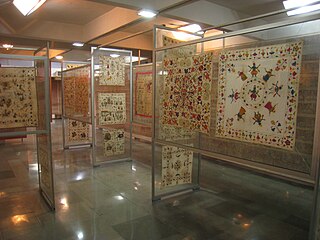
Embroidery in India includes dozens of embroidery styles that vary by region and clothing styles. Designs in Indian embroidery are formed on the basis of the texture and the design of the fabric and the stitch. The dot and the alternate dot, the circle, the square, the triangle, and permutations and combinations of these constitute the design.
Sohna is a town and a municipal committee in the Gurgaon district of Haryana, India. A popular tourist weekend and conference retreat, it is on the highway from Gurgaon to Alwar near a vertical rock. Sohna is known for its hot springs and Shiva temple. Sohna tehsil is part of Ahirwal Region. Major communities in Sohna are Rajputs, Ahirs, Gujars, Jats, and Muslim Gujjar. Gurgaon district is divided into 4 sub-divisions each headed by a Sub-Divisional Magistrate (SDM): Gurgaon, Sohna, Pataudi and Badshahpur.
The New World Tapestry was for a time the largest stitched embroidery in the world. It depicts English colonisation in North America, Guyanas, and Bermuda between the years 1583 and 1642, when the English Civil War began.
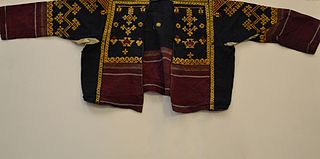
Kasuti is a traditional form of folk embroidery practised in the state of Karnataka, India. Kasuti work which is very intricate sometimes involves putting up to 5,000 stitches by hand and is traditionally made on dresswear like Ilkal sarees, Ravike/Kuppasa(Khana) and Angi. The Karnataka Handicrafts Development Corporation (KHDC) holds a geographical indications (GI) protection for Kasuti embroidery which provides intellectual property rights on Kasuti to KHDC.
The Banjara are a historically nomadic trading caste who may have origins in the Mewar region of what is now Rajasthan.
Ranjit Poojari Naik was an architect and social worker who helped Mumbai slum dwellers. He had an involvement in nearly 50 slum redevelopment projects and was director of the People's Participation Programme. An activist for the Banjara people, Naik spoke at the second World Romani Conference in 1978, where he delivered a paper titled Banjara from Barothan.

Banjara Hills is an urban commercial centre and one of the most affluent neighbourhoods in Hyderabad, Telangana, India. This is an upmarket locality close to Jubilee Hills. This area was a hilly forest and was least inhabited in the past. Only few royal members of the Nizam's dynasty lived here, which was a hunting ground for them. Even with its history and status, this area now has completely been transformed to an urban commercial centre consisting of an array of high-end hotels, restaurants, night clubs and office buildings of global corporations. Banjara Hills is segregated by its road numbers, with each road having its own importance: the numbers start from 1 and end at 14.
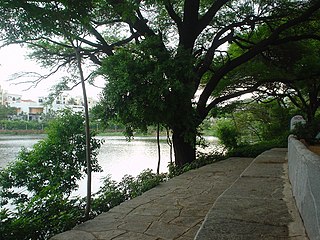
Film Nagar, also known as Tinsel Town or Tollywood, is a neighborhood in the western part of Hyderabad, Telangana, India. It is notable for its place as the home of the entertainment industry, including several of Tollywood's historic studios. The area is majorly a part of Jubilee Hills and also a small part of Banjara Hills. The area is the headquarters of Telugu film industry, and the residential hub of many Telugu film personalities like Allu Arjun, Nagarjuna, Junior NTR, Brahmaji, Mohan Babu, Balakrishna etc to name a few.
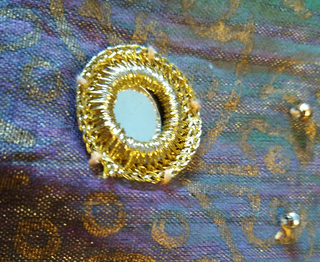
Shisheh or abhla bharat embroidery, or mirror-work, is a type of embroidery which attaches small pieces of mirrors or reflective metal to fabric. Mirror embroidery is common throughout Asia, and today can be found in the traditional embroidery of the Indian subcontinent, Afghanistan, China, and Indonesia.

English embroidery includes embroidery worked in England or by English people abroad from Anglo-Saxon times to the present day. The oldest surviving English embroideries include items from the early 10th century preserved in Durham Cathedral and the 11th century Bayeux Tapestry, if it was worked in England. The professional workshops of Medieval England created rich embroidery in metal thread and silk for ecclesiastical and secular uses. This style was called Opus Anglicanum or "English work", and was famous throughout Europe.
Laila Tyabji is an Indian social worker, designer, writer, and craft activist. She is one of the founders of Dastkar, a Delhi-based non governmental organization, working for the revival of traditional crafts in India. She was honored by the Government of India in 2012 with the Indian civilian award of Padma Shri. She is the daughter of late Badruddin Tayyabji, ICS, who was a senior Indian civil servant and diplomat.

The Scottish Diaspora Tapestry is a large embroidery, 153 metres (502 ft) in length, crafted from 305 panels that were embroidered in 34 countries. It was the second major tapestry project to have originated from the Prestoungrange Arts Festival in Prestonpans, East Lothian, Scotland. Work on the panels began in 2012. A version of the tapestry was exhibited across Scotland in 2014 for the Homecoming. The tapestry was displayed in locations around Western Europe the following year. November 2015 was the first time that all 305 panels were shown together. In 2016 and 2017 the tapestry toured across Australia and Canada and returned to Edinburgh to go on display in May 2017.

Lambada embroidery is an art of embellishing clothes practiced by the Lambadas or Lambanis, the tribe in Sanduru, the Banjaras of Bellary and Bijapur in Karnataka, Hyderabad in Andhra Pradesh. Lambada embroidery consists of the patchwork, appliqué, beadwork and embroidery together.
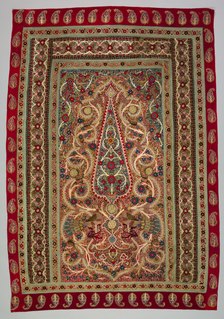
Rasht embroidery is a Persian art and handicraft. It is a decorative felt panel with a fine detail chain stitch embroidery, originating in the city of Rasht in Gilan province, Iran. This style of craft flourished in the 16th and 17th centuries in what is now Northwest Iran.
References
- ↑ Tankha, Madhur (31 January 2011). "Surajkund Mela begins on Tuesday - The Hindu". The Hindu.
- ↑ "The Hindu : Rich tapestry of embroidery". Archived from the original on 16 February 2013.
- ↑ "The Hindu : Karnataka News : CCIE's Cottage Mela". Archived from the original on 12 March 2011.